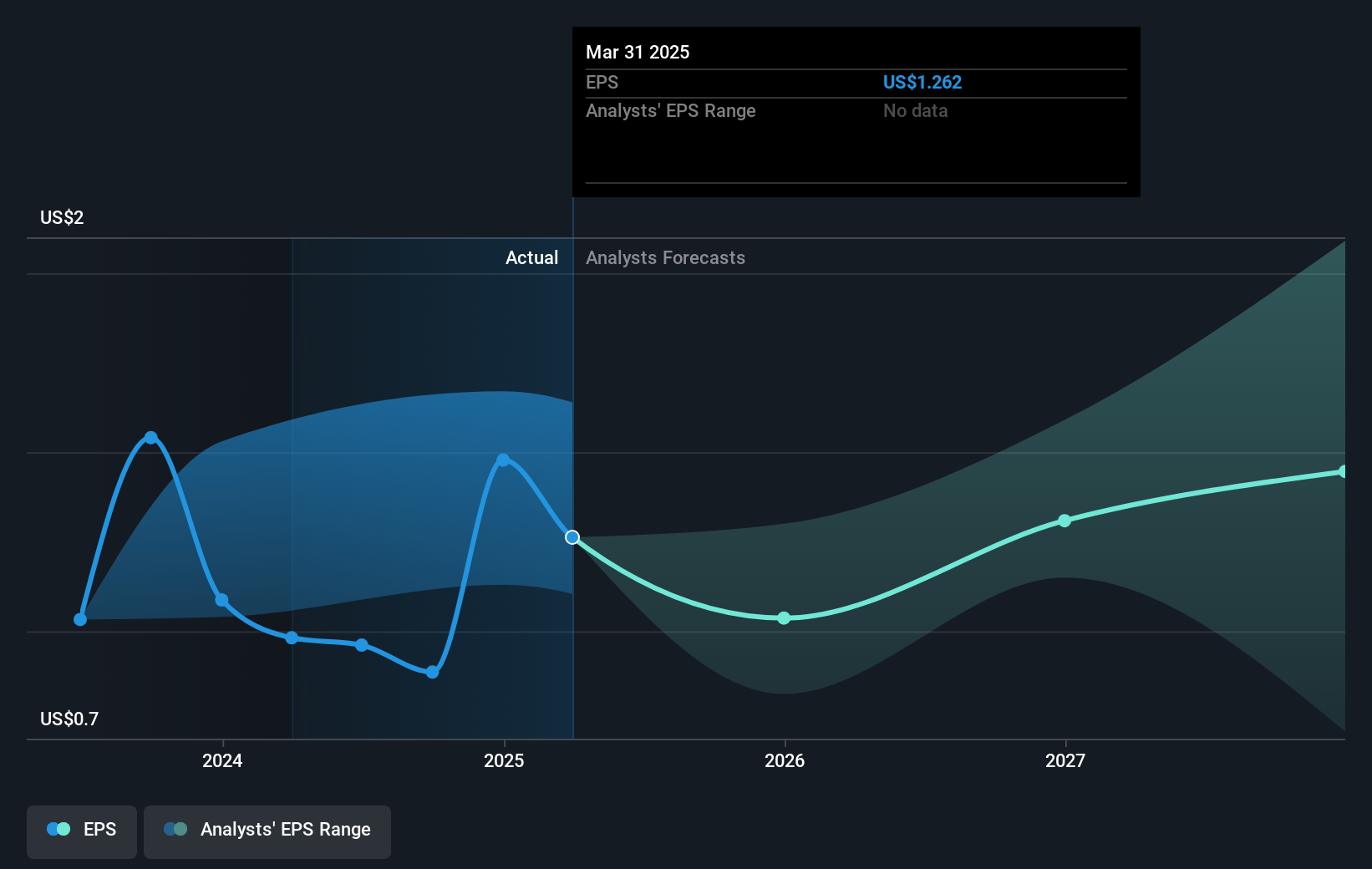Key Takeaways
- Ford's focus on U.S. manufacturing, cost reductions, and quality improvements is enhancing market share, optimizing pricing, and boosting net margins and earnings.
- Strategic growth in electric vehicles and Ford Pro's software services signals a shift towards high-margin revenue streams, supporting long-term revenue growth.
- Tariffs and supply chain disruptions create uncertainty for future earnings, while international challenges and financing risks threaten Ford's profitability and revenue stability.
Catalysts
About Ford Motor- Develops, delivers, and services Ford trucks, sport utility vehicles, commercial vans and cars, and Lincoln luxury vehicles worldwide.
- Ford is leveraging its strong U.S. manufacturing footprint as a competitive advantage, particularly in the face of potential tariffs, which may allow the company to increase market share and optimize market pricing dynamics, positively affecting future revenue and earnings.
- The company is making significant progress on cost reductions and quality improvements, aiming for $1 billion in net cost reductions excluding tariffs. These efforts are expected to enhance net margins and boost overall earnings.
- Product launches, including new electric and hybrid vehicles in both North America and Europe, show potential for future growth in revenue and market share, particularly in segments less affected by imported competition.
- Ford Pro's growth in software and services, with a 20% increase in paid subscriptions and higher revenue per unit, highlights a strategic shift towards high-margin recurring revenue streams, improving overall net margins and earnings.
- Continued expansion and investment in battery and manufacturing capacity in key U.S. locations may capitalize on future demand for electric vehicles, supporting long-term revenue growth and capital efficiency.
Ford Motor Future Earnings and Revenue Growth
Assumptions
How have these above catalysts been quantified?- Analysts are assuming Ford Motor's revenue will decrease by 1.6% annually over the next 3 years.
- Analysts assume that profit margins will increase from 2.7% today to 3.2% in 3 years time.
- Analysts expect earnings to reach $5.7 billion (and earnings per share of $1.29) by about May 2028, up from $5.0 billion today. However, there is a considerable amount of disagreement amongst the analysts with the most bullish expecting $8.4 billion in earnings, and the most bearish expecting $2.9 billion.
- In order for the above numbers to justify the analysts price target, the company would need to trade at a PE ratio of 9.6x on those 2028 earnings, up from 8.3x today. This future PE is lower than the current PE for the GB Auto industry at 13.9x.
- Analysts expect the number of shares outstanding to decline by 0.61% per year for the next 3 years.
- To value all of this in today's terms, we will use a discount rate of 11.41%, as per the Simply Wall St company report.
Ford Motor Future Earnings Per Share Growth
Risks
What could happen that would invalidate this narrative?- There is a significant adverse impact from tariffs, estimated at $2.5 billion gross and $1.5 billion net, which could negatively affect Ford's EBIT and overall profitability.
- Ford has suspended its full-year 2025 guidance due to near-term risks related to tariffs and supply chain disruptions, creating uncertainty for future earnings projections.
- Although Ford is making progress on cost and quality improvements, continued industry-wide supply chain disruptions and competitive responses to tariffs could impact production stability and net margins.
- Ford's international operations, particularly in Europe, face challenges from exchange rate impacts and rising competition, which could affect overall profitability and revenue streams.
- The increased reliance on longer-term financing options by consumers, amid tariff-induced price increases, might lead to an elevated risk of defaults, potentially impacting Ford Credit's earnings.
Valuation
How have all the factors above been brought together to estimate a fair value?- The analysts have a consensus price target of $10.087 for Ford Motor based on their expectations of its future earnings growth, profit margins and other risk factors. However, there is a degree of disagreement amongst analysts, with the most bullish reporting a price target of $17.0, and the most bearish reporting a price target of just $7.0.
- In order for you to agree with the analyst's consensus, you'd need to believe that by 2028, revenues will be $174.3 billion, earnings will come to $5.7 billion, and it would be trading on a PE ratio of 9.6x, assuming you use a discount rate of 11.4%.
- Given the current share price of $10.44, the analyst price target of $10.09 is 3.5% lower. The relatively low difference between the current share price and the analyst consensus price target indicates that they believe on average, the company is fairly priced.
- We always encourage you to reach your own conclusions though. So sense check these analyst numbers against your own assumptions and expectations based on your understanding of the business and what you believe is probable.
How well do narratives help inform your perspective?
Disclaimer
AnalystConsensusTarget is a tool utilizing a Large Language Model (LLM) that ingests data on consensus price targets, forecasted revenue and earnings figures, as well as the transcripts of earnings calls to produce qualitative analysis. The narratives produced by AnalystConsensusTarget are general in nature and are based solely on analyst data and publicly-available material published by the respective companies. These scenarios are not indicative of the company's future performance and are exploratory in nature. Simply Wall St has no position in the company(s) mentioned. Simply Wall St may provide the securities issuer or related entities with website advertising services for a fee, on an arm's length basis. These relationships have no impact on the way we conduct our business, the content we host, or how our content is served to users. The price targets and estimates used are consensus data, and do not constitute a recommendation to buy or sell any stock, and they do not take account of your objectives, or your financial situation. Note that AnalystConsensusTarget's analysis may not factor in the latest price-sensitive company announcements or qualitative material.






